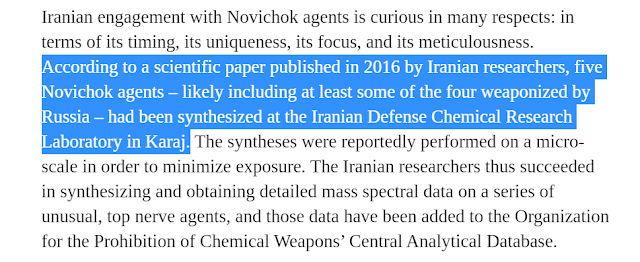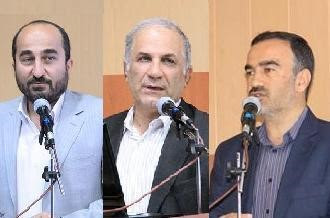Revealed: SPND involved in research on Novichok chemical agents, Part I
Today, we can reveal that the primary Iranian laboratory responsible for work on chemical warfare agents, including novichoks, has frighteningly close ties to SPND (سازمان پژوهش و نوآوری دفاعی), the shadowy organization that ran Iran's pre-2003 nuclear weapons program and continues to dabble in dual-use research with WMD applications.
We'll also reveal in our next post that the main Iranian scientist responsible for synthesizing these agents is on the SPND payroll.
And, even more disturbingly, that this individual has also spearheaded Iran's efforts to infiltrate and undermine the international organization charged with preventing the proliferation of chemical weapons.
How do we know all this? Read on...
Iran and chemical weapons: some background
At face value, Iran abhors chemical weapons. Iran is one of the few states to have suffered wide-scale chemical weapon (CW) use against its population, and has maintained a famously strong public stance against CWs since the chemical attacks against it by Saddam Hussein during the Iran-Iraq War. Iran is a party to the Chemical Weapons Convention (CWC) - the main international treaty that prohibits production and use of chemical weapons, and monitors their research by states for defensive purposes - and a vigorous participant at the Organization for the Prohibition of Chemical Weapons (OPCW), the international chemical weapons watchdog charged with monitoring state activities relevant to the CWC.
Look harder, though, and a more complicated picture emerges. Iran has opposed efforts by the OPCW to investigate Syrian government chemical weapon attacks during the civil war there. And various nations have repeatedly voiced suspicions that Iran has been building dual-use capabilities to develop chemical weapons, based on procurements of red-flag items from abroad, and on other intelligence information. The United States Treasury Secretary Steven Mnuchin said in 2020 “Iran’s development of WMD is a threat to the security of it’s neighbours and the world”
Against that backdrop, it's somewhat alarming to learn that Iran is one of the few states worldwide that are actively involved in synthesizing chemical agents, including VX (the substance used by North Korean assassins to kill the brother of Kim Jong-Un in Malaysia in 2017) and mustard gas. This work, which is detailed in various openly available research papers, is nominally conducted in order to assist the OPCW with building reference samples for use in the organization's testing and monitoring work.
Even more alarmingly, since 2016, research papers have shown that the same group of scientists involved in Iran's work on VX and mustard have branched out into the production of even more dangerous chemical agents, including those from the novichok class. Remember that name? Novichoks are a class of organophosphate nerve agents invented in secret by the Soviet Union decades ago. They are estimated to be more than five times as toxic as VX, and have been used with appalling effects on the human body as recently as 2018, when an innocent individual was killed in the United Kingdom after a failed assassination attempt.
Iran's dabbling in the novichok area has received only limited public attention, and if you're not a subscriber to a publication like Spectroscopy Now you can be forgiven for having let it passed you by.
Indeed, our interest in the subject was only piqued when we read an article from the Begin-Sadat Center for Strategic Studies (BESA), an Israeli think-tank, that highlighted the particular Iranian laboratory that was responsible for Iran's novichok synthesis. As that study noted:
The author provides no more detail on the Defence Chemical Research Laboratory (آزمایشگاه تحقیقات شیمی دفاعی or آزمایشگاه شیمی دفاعی, aka DCRL). And it's not an institution that we'd heard of before. Google it and you'll find less than a dozen hits; a website that's been down for years; and a PO Box in Karaj to the west of Tehran.
Sounds mysterious. So we thought we'd take a look!
Where it all happens: the Defence Chemical Research Laboratory
Here's what's known about the Defence Chemical Research Laboratory. According to archived versions of the DCRL's website, the DCRL provides chemical-related analytical and equipment testing and manufacturing services to Iran's military. It's also one of the OPCW's global networks of validation laboratories, meaning that it is equipped and certified to produce and handle the most toxic nerve agents. The DCRL's status as an official OPCW laboratory also means that the DRCL is subject to OPCW access and monitoring, so it's not a clandestine facility by any stretch.
What isn't at all clear is just where the DCRL is located - and who controls it. The OPCW knows the answer to the first of these questions, but we don't think they really know the full answer to the second. And the public knows neither.
We think we can help out on those fronts.
First, the DCRL's location. Buried in OPCW reports, we found a more specific address for the DCRL: at the 27th kilometer of the Karaj Special Road, which leads out from Tehran's western suburbs to the satellite city of Karaj.
That address rings alarm bells. It's the well-known location of a notorious industrial complex owned by the Shahid Meisami Group (گروه شهید میثمی or مجتمع شهید میثمی). Not heard of them? You'll probably not be surprised to learn that Shahid Meisami's remit is almost exactly the same as DCRL's: it's a military-associated pharmaceutical and chemical facility involved in production of equipment for defence against chemical and biological weapons. And sometimes Shahid Meisami's work is rather more than defensive: in 2019 the United States specifically called out the Shahid Meisami Group for producing munitions capable of dispersing debilitating chemicals.
What hasn't been revealed until today is that Shahid Meisami is closely tied to SPND - and as recently as 2016, was actually a sub-group of SPND.
We've found patent documents buried in an Iranian corporate registry that show that in 2016, SPND attempted to register a logo for the Shahid Meisami Group. Brilliantly, the applicants also made sure that the Shahid Meisami logo also had the Farsi name of SPND on top - clearly denoting for us that Shahid Meisami was at that time a subsidiary of SPND.
Here's the logo with our annotation. You'll have to squint to read the Farsi text:
Not convinced? Well, there's a vast web of connections between Shahid Meisami and SPND that you can find with a little more digging online. For example, Shahid Meisami's CEO, Dr Ali Pour Asad (aka Ali Pourasad or علی پور اسد), is a director of several SPND front companies, according to business documents that we've found. And we've seen various other senior alumni of Shahid Meisami, like biotechnologist Dr Ali Gharibian (علی غریبیان), conducting business on behalf of SPND. With all of these connections, we're confident that Shahid Meisami and its facility at the 27th kilometer of the Karaj Special Road is either part of SPND, or very closely affiliated with it.
Now back to the DCRL. Given that Shahid Meisami and the DCRL share a) an address and b) core functions - namely a key role in Iran's "defensive" chemical weapon infrastructure - we're suspect that the DCRL is actually also part of SPND.
And we're also beginning to think that DCRL's most important scientist, and the man responsible for the lab's most sensitive work on VX and novichoks, is also SPND to the gills. More on that next post!










Comments
Post a Comment